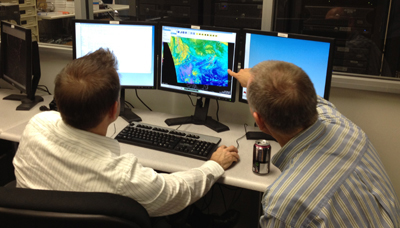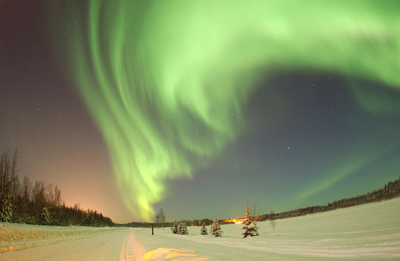Students get a forecaster's view
Meteorology departments to gain access to NWS software
May 18, 2012 - by Staff
May 18, 2012 - by Staff
May 18, 2012 • University students and faculty soon will have the chance to peer at day-to-day weather through the same lens used by National Weather Service meteorologists. A new version of the NWS’s workhorse graphics software could begin making its way to campuses in fiscal year 2013 through UCAR’s Unidata program.
Up to now, the Advanced Weather Interactive Processing System (AWIPS) has been restricted to NWS employees. With the creation of AWIPS II, NOAA and longtime contractor Raytheon are moving to an open-source, Java-based approach. The upgraded system is now being tested at a handful of NWS offices, including those in Omaha, Norman, and Boulder.

Forecasters Mark Klein and Keith Brill (NOAA Hydrometeorological Prediction Center) evaluate AWIPS II features at a testbed facility in Camp Springs, Maryland. (Photo courtesy NOAA.)
Unidata is a natural choice for bringing AWIPS II to universities. From its beginnings in the 1980s, Unidata has supported GEMPAK, a graphics program used heavily at NOAA’s National Centers for Environmental Prediction (NCEP) as part of its own version of AWIPS. Through Unidata, more than 300 universities have gained free access to GEMPAK, along with user support. The software has been a vital tool for both real-time weather analysis and research, says Unidata director Mohan Ramamurthy. “It’s been a terrific partnership,” he says.
The need for GEMPAK will lessen as the NWS, NCEP, and Unidata all shift to AWIPS II. However, Unidata will continue to fully support GEMPAK for 18 months after the advent of AWIPS II. Existing tutorials and documentation will be kept online even after that point.
Gerry Creager (Texas A&M University) and Kevin Tyle (University at Albany, State University of New York) are the first two beta testers to receive the AWIPS II software from Unidata. Testing at other campuses will ramp up later this year, with a goal of making evaluation copies of the software available to all interested Unidata members by the time AWIPS II is adopted nationally by the NWS in 2013.
Several Unidata staff paid a visit to the Boulder NWS office in March for a first-hand look at the benefits of AWIPS II, led by meteorologist in charge Nezette Rydell and forecaster David Barjenbruch. The system’s new features include improved zooming and panning capabilities. "Speed, efficiency, and visualization quality are essential to us as working forecasters," Barjenbruch told the group.

Forecasts and other products from NOAA’s Space Weather Prediction Center for a variety of solar phenomena, including auroras, will be accessible to university students and faculty through Unidata’s AWIPS II feed. (Wikimedia photo by Senior Airman Joshua Strang, U.S. Air Force.)
Along with imagery of supercell thunderstorms and hurricanes, AWIPS II will provide Unidata members with a stream of solar data. NOAA’s nine national centers include the Space Weather Prediction Center (SWPC), whose products will become part of AWIPS II.
NOAA’s Michelle Mainelli—who serves as a liaison to Unidata in the AWIPS II transition—pointed out some of the resulting benefits at an April 24 talk at the UCAR-facilitated Space Weather Workshop in Boulder. She noted that AWIPS II will allow new short-term forecasts of aurora potential to be harmonized with cloudiness outlooks, so users will know if those shimmering displays might actually be visible at a given spot should they develop.
“Many meteorologists haven’t thought much about space weather products,” says Ramamurthy, who notes the potential for expanding Unidata’s user base to solar specialists.
Thinking along the same lines is SWPC space weather services branch chief Brent Gordon. “I would like to see the space weather research and university communities be able to take advantage of the same programs the terrestrial weather community has been offered through Unidata,” he says. “Bringing space weather to AWIPS II is the first step in this process, and I’ll be excited to see how the community responds.”